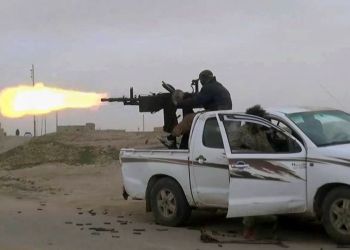This post is also available in:
![]() العربية
العربية
It is historically known that in 1916; Deir Ezzor province warmly received and welcomed thousands of Armenian Christians fleeing the massacres and atrocities they were subjected to in Armenia during World War 1.
The fleeing Armenian children
The Armenian Christians mixed with the people in Deir Ezzor’ society to a degree that the only thing that could distinguish them from others was the color of both their skins and eyes. Some even began to identify themselves as being part of the Arab tribes in the province.
Abu Mahmoud, an Armenian Christian who arrived in a village in Deir Ezzor province after escaping the brutality and crimes of the war in Armenia, worked in an agricultural field belonging to one of the tribal leader in the village, and learned the Arabic language. As a result, he was regarded as being a native civilian of Deir Ezzor. He got married to a daughter of one of the people in the village. As time passed, Abu Mahmoud’s income improved that he could buy an agricultural land for himself.
Abu Mahmoud says, “More than 10 Armenian Christian families are living in this village, and the only thing we know is that we belong to it. We have established a firm social relationship with the others living in here, despite the fact that some old people still call our family Armenian. We are considered as being a building block of this region. We carry the same names, have the same traditions and follow the same religion (Islam). This situation in the village is prevalent across Deir Ezzor. Some have even taken the names of the families that hosted them after arriving in the province.
Deir Ezzo’s Christians
Some Christian families continued using the same names and following the same religion and traditions of their forefathers, mainly those who came to Syria as a family not just as individuals.
There were very known Armenian Christian families in Deir Ezzor. They were particularly present in the city of Deir Ezzor with a small presence in the city of al-Bukamal and some individuals in the city of al-Mayadeen.
Yamin al-Hakeem, a Christian from the city of Deir Ezzor who worked as a media activist, says, “There are around 85 Assyrian homes, with 85 homes belonging to Romans, Kaldan and Armenians. The total number of these Christian homes is estimated at 4 thousand. Moreover, they are all scattered through the neighborhoods of al-Qusour, al-Rushdiya and Cinema Fouad.
Most of the Christians that used to live in Deir Ezzor practised crafts work, and they were an integrated community, linked and mingled with each other. Most of the goldsmithing workshops in Deir Ezzor belonged to them; in addition to silversmithing and the repair of clock and other stuff. There were also mechanic garages mostly owned by them. Christians were also engaged in public life as you could find among them who was an engineer and a doctor.
In the city of Deir Ezzor Christians were not differentiated from others as they wore the same dress and clothes. They had the same habits to a degree that you could see women covering their heads in line with the people of Deir Ezzor. Christian’s children were hardly distinguished from other children because of their full integration into the society.”
Christian during the Syrian Revolution
There was no discrimination against the Christians and Muslims for decades in Syria due to the strong and well-built social relationship characterizing Deir Ezzor province such as the hospitality and generosity of its people. No harassment or religious atrocity against the Christians was ever recorded at that time.
Christians practiced their religious rituals at five churches; and they are as follow: The Armenian Martyrs Church, which was recognized by the Vatican in the nineteenth of the last century. The Orthodox Assyrian Church, the Catholic Assyrian Church, the Catholic Armenian Church, the Latin Kaboshiya Church.
Christian involvement in the beginning of the Syrian Revolution was limited in significance because of many reasons. First, they were a minority who constituted only 1 percent of the total inhabitants in Deir Ezzor city.
The protests started from mosques, causing some of them to think of the revolution as being a religious one, making many of them refrain from joining it. Some were also tricked by the Assad-regime who used and promoted the idea of “Assad being the only protector of minorities in Syria”.
However, none of this prevented the educated young people from being involved and engaged in the revolution. Christian male and female activists began to appear among the Christian families in Deir Ezzor. One of the most notably known activists was the media activist Yamen al-Hakim who says, “No Christian soldier in the ranks of the Assad-regime defected, except for a guy named Micheal, born in Aleppo, who defected from the regime in Deir Ezzor.
The policy of neutrality that was adopted by the Christian families did not serve as a shield against Assad brutality and satanic cruelty as he shelled and bombarded indiscriminately the neighborhoods where they lived. With the seizure of large parts of Deir Ezzor city by the FSA, the Assad-regime attacks on the city increased and became more atrocious. The city faced intense bombardments that pushed both Christians and Muslims to leave the city with no other choice.
Christians of Deir Ezzor had the same fate as that of their brothers the Muslims in the province. They all left behind their homes, memories heading towards the unknown and looking for safety. Their main destination at that time was either Hasakah or Damascus, with some who left the country and moved to Europe and the US.
Nevertheless, some families decided to stay in the city of Deir Ezzor despite the heavy aerial bombardments they witnessed on a daily basis. They moved to the FSA-held neighborhoods of Deir Ezzor city where they lived in tolerance and co-existed with the other families living there at the time. Some Christians even cooperated with the FSA by offering food and water to local FSA fighters who never discriminated against the components of their society based on religious and racial beliefs. The only label was if you are part of the revolution or against it, and if you were neutral you were considered as being part of the city, you witness what it witnesses and suffer what is suffers from.
With the arrival of Nusra Front and its extremist and brutal ideology in Deir Ezzor city, Christians became concerned about the possibility of being treated badly or discriminated against. However, Nusra Front fighters were just local civilians from the same city and set a good example of religious tolerance and co-existence. Christians were in few numbers in their held areas, as Assad forces were in control in all the churches. The only thing that was forbidden during the rule of Nusra was the selling of alcohol.
The regime intensively targeted Christian churches along with the mosques in the areas out of its control in city, which resulted into total destruction of these religious and sacred buildings.
ISIS and the departure of Christians from Deir Ezzor
The siege imposed by the Assad-regime and its heavy bombings on the liberated areas in Deir Ezzor city was the main reason many civilians fled their city. Not one single Christian remained inside. This coincided with ISIS’ takeover of Raqqa where it imposed different arbitrary taxes on its people, and started executing any one showing any sing of dissidence.
The Christians of Raqqa were threatened by the group and given two stark options:
- Leave the city to confiscate their shops, homes and all their properties in general.
- To pay Jizyah so that the group grants them safety in its held areas.
But what kind of safety is that in a time where the city is exposed to heavy bombardment that does not differentiate between Christian or Muslim or any other people of different colors. As reports about Deash advancing towards the province of Deir Ezzor increased, many Christians living in the province decided to flee. The only ones that remained was a Christian family that is now living in al-Qusour neighborhood as they could not find a way out of the besieged areas in the city.











